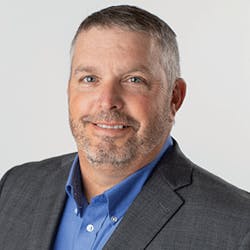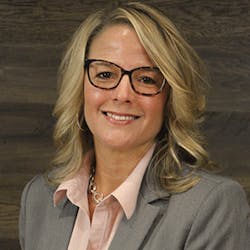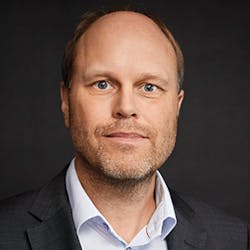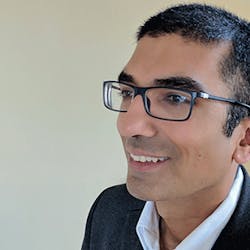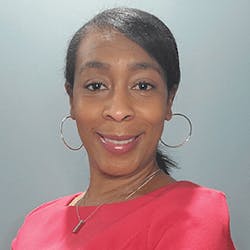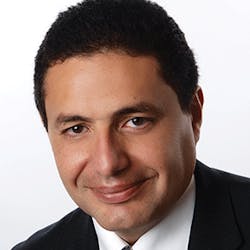ISE recently sent to these Visionaries several questions, asking them to select 3 to answer. Learn what our execs have to say about geographic broadband disparity, RDOF funding, network capacity planning, home automation, and private networks.
TOPIC: WIRELINE TO WIRELESS 5G DENSIFICATION
Flexibility is key as we move from 300,000 sites to over 1 million sites needed for ubiquitous 5G. That means small cell antennas must become as common as fire hydrants. In urban and suburban neighborhoods we can expect to see them sprout up in many different environments. We may see these small cell radios being attached to a strand, mounted to an existing pole, or even deployed in a smart pole specifically designed to house these radios in an aesthetically pleasing manner.
Currently, states are developing laws to establish baseline standards like streamlined applications to access public rights-of-way, caps on costs and fees, and consistent timelines for consideration and processing of cell siting applications.
What are some creative solutions to help expedite the massive number of sites required for ubiquitous 5G?
TOPIC: BROADBAND DISPARITY DATA
A recent study released by the ACA highlights data about the disparity in broadband availability by income and geography. "Addressing Gaps in Broadband Infrastructure Availability and Service Adoption: A Cost Estimation & Prioritization Framework," found that about 12 million US households, including 8.2 million in partially served Census blocks not previously accounted for in FCC data, don’t have access to 25/3 Mbps broadband (currently the speeds the FCC uses to define "broadband").
In large part, the data shows that income is the barrier to adoption, regardless of geography. About 30 million, or about 25%, of US households do not subscribe to a residential fixed broadband service for reasons other than network availability, with 36% of non-subscribing households earning less than $20,000 per year.
(Source: https://acaconnects.org/wp-content/uploads/2021/06/Addressing-Gaps-in-Broadband-Infrastructure-Availability-and-Service-Adoption-ACA-Connects-and-Cartesian-June2021.pdf)
What can providers do to help address this daunting problem?
TOPIC: TECHNICIANS ARE THE FACE OF THE BRAND
Talk about the importance of field technicians. What are you doing to help evolve both their soft skills and the technologies they use so they make positive first and last impressions about your company to end users?
TOPIC: ENERGY
If energy were free, what would your team do differently?
(We’re not talking about Battery or Back-Up power; we mean the power of Time and Mind-Share.)
TOPIC: RDOF FUNDING – IS IT ENOUGH?
There were 180 winning bidders in the Phase 1 funding auction who are sharing a portion of the RDOF grant. Over 99% of all auction winners committed to service at speeds of at least 100/20 Mbps, with 85% committing to gigabit broadband. The top 10 are shown below:
Phase 2 of the FCC’s RDOF will focus on improving service to underserved premises: homes and businesses that have slow or expensive Internet or in census blocks that are partially served.
But before the auction for phase 2 funding begins, the FCC’s new Data Task Force will be redoing data collecting on broadband Internet access across the country so that a more granular and accurate picture of Internet availability will be available. Currently, widespread data inaccuracies in the FCC’s maps have led to major coverage gaps, skipping over many areas in need. (Source: www.satelliteInternet.com)
Share your thoughts about this and the impact it has on your company.
TOPIC: SKILLS GAP
According to a recent survey by EY, 59% of companies believe there’s an industry-wide shortage of the type of skills that would help accelerate their digital transformation efforts. VIAVI Solution’s 14th Annual State of the Network global study supports this, and shares that one of the top challenges to successfully monitor network health is related to finding the requisite talent to solve performance issues. (Sources: www.ey.com; www.stateofthenetwork.com)
What are you doing for your team members to help close this gap? What is the one piece of advice you can give to our 27K readers about growing their career?
TOPIC: PRIVATE NETWORKS
With 5G technologies, organizations now have the power to make informed decisions whether to join a commercial network or to invest in infrastructure to manage their own private network. This is due to the release of unlicensed spectrum for industry verticals, allowing organizations to own the wireless spectrum they use for the network, along with the network base stations and other infrastructure. This allows companies full control over the network and grants isolation of its users from other Mobile Network Operators’ (MNOs) public networks.
What opportunities and challenges does this pose for communications service providers (CSPs)?
TOPIC: HOME AUTOMATION = $$$
Today’s home automation packages are quite impressive. They cover everything from thermostats, indoor cameras, appliance modules, light bulbs, to doorbell cameras and pet motion monitors. According to recent research, however, price and simplicity of use can be a deterrent to many consumers considering adopting home automation. (Source: www.parksassociates.com)
What percent of your customers are adopting these packages? What are some challenges you are encountering, and how can providers help overcome those challenges?
TOPIC: WIRELINE TO WIRELESS 5G DENSIFICATION
At AT&T, our teams are continuously looking for new, aesthetically appealing, and simple-to-deploy solutions. One example is our work with a company that has developed a small form factor device that plugs into the power socket of streetlights. This eases deployment and blends in with the existing infrastructure. Beyond the physical devices, we have also invested in tools that use artificial intelligence to help us identify locations ideally suited for deployment.
TOPIC: BROADBAND DISPARITY DATA
Everyone should be connected to the Internet and the pandemic only emphasized this need. So, to bridge this digital divide, we believe bold Federal action and funding has to occur. At AT&T, we’re doing our part by: working together with legislative and regulatory officials; expanding and upgrading our networks to provide the fast and reliable Internet access people need; and we also made a $2 billion commitment over the next 3 years to help solve this issue. Longer term, through network planning and buildout, combined with comprehensive policy changes, we will be working with Congress and the FCC to develop solutions that are affordable, accessible, and sustainable. Our hope and expectation is that other providers will continue to do the same.
TOPIC: TECHNICIANS ARE THE FACE OF THE BRAND
Our customer-facing teams are the primary representatives of our brand, and that special honor includes our field technicians. They hold strong relationships with our customers, especially when it comes to installing new services and resolving any existing service issues, so we guide them by encouraging them to keep 4 simple commitments in mind: Own It, Make It Personal, Be Authentic, and Make It Matter. By following these commitments, our technicians are able to show our customers that we both appreciate and value them.
Technically speaking, we have several internal tools that help our technicians better serve customers — from two-way communication with the customer to proactively monitoring network quality before an outage occurs. Every interaction matters, so we have tools and systems in place throughout every aspect of the customer’s journey with us.
TOPIC: TECHNICIANS ARE THE FACE OF THE BRAND
Clearfield makes gaining insight and feedback from field technicians a high priority for designing more craft-friendly products, which saves money on the costliest part of the fiber deployment: labor. Clearfield’s technical trainers and our experienced team of Application Engineers meet with our customers in the field to get to know their needs, to educate them on Clearfield products and technology, and to support them when needed, such as with our "first-time install" guidance. In addition, Clearfield offers Certified Fiber Optic Technician (CFOT®) training accredited by the Fiber Optic Association (FOA) as the foundation for building knowledge, skills, and abilities, for fiber technicians.
TOPIC: RDOF FUNDING – IS IT ENOUGH?
The message to think through is that the initiatives going on right now with government funding are not just about solving short-term issues. It is about how we future-proof the economy with broadband. Only about a fifth to a quarter of homes in the US are wired with fiber that will allow a gigabit per second of service, which is what people really need to be productive. RDOF resembles how electricity was brought into the country a hundred years ago. Back then they were never going to string electrical wires in remote parts of the country without support from the government. But that government funding yielded a tax base and an economic base to really globalize what the US would be capable of doing. With RDOF, the installation of fiber itself can create new jobs and a craft industry of learning to splice and run cable, somewhat akin to the Works Progress Administration of the 1930s. This new jobs initiative can provide an extremely strong living wage for people who are good with their hands and choose to bypass college to earn a living.
TOPIC: SKILLS GAP
To grow in our jobs requires that we keep learning. The more skills we acquire, and the more we’re able to know, the more value we can offer to our employers. The goal is to become the very best at what you do by continuing to learn, and to hone your skills and capabilities to the point where they become highly regarded and sought after by your coworkers and professional peers. That’s why we have invested in and expanded Clearfield College to include Online Learning.
For more information, please email [email protected]. Follow Kevin on Twitter @kevinmorgan520 and LinkedIn @kevinmorgan1.
TOPIC: TECHNICIANS ARE THE FACE OF THE BRAND
At CTC, we strive for the best possible member experience. It may start with marketing or sales but it always ends with our technicians. Properly trained and qualified technicians are an essential part of any successful communications company. Our technicians are constantly learning new technologies and skills. We do this by working with several vendors as well as providing frequent in-house trainings. Our technicians are well-versed in CTC’s values: member experience, accountability, competition, innovation, and performance. We give them the proper tools they need and a healthy amount of autonomy. If our technicians don’t have sufficient confidence or product knowledge, our customers will see right through that. Our entire team — technicians included — believe in CTC’s brand, the technologies they install, and the importance of leaving a positive lasting impression with the customers that we serve.
TOPIC: RDOF FUNDING – IS IT ENOUGH?
Accurate data mapping continues to be problematic for providers across the country. In Minnesota, we are fortunate to have statewide maps (provided by the Office of Broadband Development) that are more accurate than the federal maps. Inaccurate mapping impacts our planning and funding requests, and leaves thousands of rural Americans with no option for getting reliable broadband. Mapping is a consumer issue that need to be addressed immediately as more federal funding is being dedicated to broadband deployment.
TOPIC: SKILLS GAP
Our team has been working for the last 10 years to find and create the best automated systems for network monitoring, performance, and reporting. Along with hiring interns that we’ve trained internally, this allows our senior level technicians to concentrate on project planning, design, and implementation. Automation has allowed our level one technicians to take a more hands-on approach to complex resolutions, thereby freeing up senior technicians’ time. We’ve focused on provisioning automation as well. Then, our senior staff doesn’t need to participate in circuit creation and provisioning. Advice? It takes hundreds of hours of time to implement these systems but in the long run these changes will simplify the processes and gain you valuable time, while having the least impact on your customer base.
TOPIC: WIRELINE TO WIRELESS 5G DENSIFICATION
First and foremost we need to manage the message! It’s not news that 5G has generated quite a few concerns and conspiracy theories over the past couple years. Even more so because of that, carriers and fiber providers need to help economic development leaders in target markets communicate the innovative technologies and future financial benefits to a community with 5G deployment.
I like the "help me help you help me" approach. To me this means bringing permitting and joint use authorities into the loop from the beginning. Let them be part of the project planning, so that they play a part in the process by collaborating on creative solutions such as innovative construction methods, streamlining permits and joint use in a way that they get to share in the success. If we win, everyone wins!
TOPIC: BROADBAND DISPARITY DATA
Let’s take a closer look at the problem. Could the fact that a speed test on my iPhone just reported 24.7 down and 2.66 Mbps up be a contributing factor? If my household income was strained and I didn’t have the discretionary funds, I doubt I would pay for 2 services with similar bandwidth. It would be an easy choice to select the one that I could take with me anywhere.
Additionally, Internet-enabled devices such as smart phones and tablets are considerably cheaper than laptop or desktop computers, making them much more accessible and multifunctional to those in a lower income range.
So what are our options? We have to bring considerably faster speeds to the customer premises for competitive prices. The demand for speed is there; providers have to bring the value proposition.
TOPIC: ENERGY
Wow! What wouldn’t we do? I have always loved the idea of an informal think tank. Organizations operate so leanly nowadays that employees are reacting, running from one fire to the next. If energy (and time) were free, imagine what we could do if we pulled cross-functional groups together for an hour of coffee and cross-talk centered around proactively identifying organizational problems and everyday frustrations. Imagine if these groups brainstormed ideas to eliminate or minimize those thorny challenges that never get addressed because they are not on fire or are at the bottom of everyone’s priority list. Knowledge is only powerful when it’s shared, and we need to create opportunities for that to happen.
TOPIC: SKILLS GAP
The fact that networks of today are pouring out performance data is not new, and yet very few service providers know what to do with all this data. The traditional skill set in an operations department is more technical, with loads of knowledge about how to physically repair cards and ports in the best way. With networks becoming increasingly dependent on software, these skill sets need to be replaced and supplemented with software engineer skills.
To close this knowledge gap without having to replace your entire team is no easy feat, but with the right company support paired with education and an openness to change among the workforce, it is absolutely doable. For those willing to retrain, the future will be bright as the combination of "old" technical skill and "new" software knowledge will be critical for network companies going forward.
TOPIC: ENERGY
Imagine if we could stop the "Business as Usual" part of our company for a week and use the full brain-capacity of every resource we have to do something that would materially change the way we operate. More than a combined 1,000 years of telecom knowledge is used to redesign systems and workflows to fit the way a telecom operator should work in 2021 and beyond. No more manual delivery configurations, no more simple billing mistakes, the end to mismatching data between systems, and the reality and full transparency of all your data both internally and externally to customers and clients. Then we could focus on making pure business decisions to meet the ever-growing business opportunities out there.
TOPIC: PRIVATE NETWORKS
Building a private 5G network over a limited area sounds like a reasonably uncomplicated task. Take several antennas connected to some form of base station, and you should be up and running with a complete closed network perfectly designed for your needs. However, the moment you step outside this private network, and your 5G devices no longer work, you will need to pair all devices with a mobile service provider. This is just one example of how taking advantage of service provider experience in constructing
similar networks may come at a slightly higher cost, but also comes with the support and reliability of a complete 5G ecosystem.
Follow Mattias on Twitter @MFridstrom.
Global SolutionsTELUS
TOPIC: WIRELINE TO WIRELESS 5G DENSIFICATION
For communications service providers with existing outside plant assets, this provides an interesting opportunity to bridge the traditional wireless and wireline divide. These outside plant assets can be leveraged to deploy more 5G infrastructure to densify network quality. Leveraging existing outside plant assets is a great way to reduce the cost of the 5G rollout. Understanding and inventorying existing assets can be a challenge, at TELUS we have used our Network Asset Visibility tool to provide an accurate view of our network to 5G planners and field teams.
TOPIC: PRIVATE NETWORKS
For incumbent CSPs, private network operators are a potential disruptor. However, there’s also a huge opportunity for mutually beneficial partnerships. The traditional areas of partnership will remain, and the private networks will, of course, need access to interconnection points. There is also an opportunity to partner with private network operators in areas CSPs excel at. For example, TELUS has a Network Asset Visibility tool available to our partners to accelerate network rollouts. Additionally, our TELUS International Digital teams assist partners with IT and network operations. CSPs can unlock a lot of hidden value within their scalable operational processes that can assist private network operators.
TOPIC: HOME AUTOMATION = $$$
Our TELUS SmartHome Security and Secure Business solutions grew over 16% year-over-year in 2020. The focus for us has been to simplify the customer experience through an integrated offering. Leveraging our superior network to integrate the latest home automation technologies. We have been able to provide our customers with a streamlined digital self-serve installation experience for the DIY crowd. Our technicians are also our in-home solution advisors working with our customers to integrate home automation and our other product offerings. Interoperability is also key to a successful home automation solution. Our approach has been to focus on standard compliant products that can integrate with the largest possible ecosystem of devices. Through our digital channels we help our customers find devices that work with their automation setup even if they need to purchase the device externally.
Follow Vishram on LinkedIn @faisal-vishram-8b4b7b41/.
Contact him at [email protected].
Verizon
TOPIC: BROADBAND DISPARITY DATA
Verizon has been on the frontlines of bridging the digital divide since 2012, most notably with our Verizon Innovative Learning program — which provides Title 1 students with free access, free devices, and a technology rich curriculum — tools that are vital to helping under-privileged served students succeed.
The program brings tech tools, resources, and teacher training, to help students develop the skills they need to excel academically, and to become engaged in STEM subjects at an early age, setting them up for future success.
So far, we’ve put technology in the hands of more than 450,000 deserving students and provided over $535M in market value towards STEM education.
The Verizon Innovative Learning program is currently in over 250 schools across the country, and, for the first time this school year, has expanded into high schools.
These efforts are all part of Citizen Verizon, our responsible business plan for economic, environmental, and social advancement, and our commitment to creating a digitally inclusive and equitable society for everyone, particularly for young people.
Through Citizen Verizon and our pillar of Digital Inclusion, Verizon is committed to providing 10 million youths with digital skills training by 2030.
TOPIC: SKILLS GAP
Verizon has an ingrained culture of continued development.
Employees at Verizon have access to a wide range of learning and development opportunities that are offered on demand. Teams across the company, including mine, are encouraged to take advantage of them. Some leaders also try to incorporate professional development into the goal of their teams. Verizon also offers tuition reimbursement opportunities as well.
Ultimately, the most important factor is a culture of learning and growth. Being a mentor, offering opportunities for cross-functional projects, and showing an interest in the professional and personal goals of your team, is how leaders can help do their part to close the skills gap and build stronger organizations.
TOPIC: PRIVATE NETWORKS
In June, Verizon Business announced the launch of On Site 5G, (https://www.verizon.com/business/products/networks/connectivity/on-site-5g/), our first commercially available, private 5G network solution in the US.
As 5G technology and capabilities advance and evolve, On Site 5G provides customers with a scalable, customizable platform to take advantage of developments in burgeoning technologies such as
Massive IoT, AI/ML, AR/VR, real time analytics, and much more.
In all, Verizon’s dedicated On Site private networks offer customers the consistent, predictable performance, security, mobility, flexibility — and now, all the capabilities of 5G — to improve
operational efficiency and accelerate digital transformation.
Follow Griffin on LinkedIn @shari-g-1854413
TOPIC: WIRELINE TO WIRELESS 5G DENSIFICATION
Imagine the time and effort required to get 4G infrastructure, including small cells, up and running. Multiply that by 20 for 5G. 5G antennas will be everywhere — from lampposts and traffic lights to rooftops and stadiums. 4G’s manual installation, testing, verification, and troubleshooting, will not be adequate. Even with massive hiring sprees and training programs, technicians cannot meet the need. Automation is the only way.
At VIAVI we are streamlining, simplifying, and automating, the entire process — from installation to 24×7 operational support using integrated tools and cloud-based workflow automation. Our goal is to achieve a near zero-touch process, where volumes of small and micro 5G cell antennas and sites are deployed, aligned, tested, verified, certified, optimized, and monitored, with a few button presses.
TOPIC: PRIVATE NETWORKS
The sixth industrial revolution powered by factory-based IoT devices requires network operators to support ultra-low latency, extremely reliable communications. That revolution has begun with smart industry verticals that are building or leasing their own private or dedicated wireless networks, frequently using unlicensed spectrum.
Intelligent software and end-to-end slicing that occurs at operators’ data centers and across the service chain is at the heart of the revolution. Cloud-based software is responsible for coordinating the millions of sensors and IoT devices, in real time and with great accuracy and reliability — ultimately elevating operators’ networks to a level of critical importance to modern infrastructure and manufacturing.
With this core criticality, these private networks require thorough testing for performance and reliability. They need to be automated, autonomous, and self-healing.
TOPIC: RDOF FUNDING – IS IT ENOUGH?
I see many opportunities to close The Digital Divide with the advances in fixed wireless access (FWA) and high-speed broadband services. 5G FWA is already being deployed and accelerated in numerous cities worldwide. While Fiber-to-the-Home (FTTH) as well as advanced cable DOCSIS 3.x/4.0 continue to offer gold standard performance for ultra-high-speed gigabit broadband in densely populated areas, low-earth orbit (LEO) satellite and the promise of Non-Terrestrial-Networks (NTN) revolutions will deliver scalable, high-speed, low-latency broadband to rural areas.
At VIAVI, we work on all fronts to verify and optimize consistent broadband experiences. We span fiber installation and verification, DOCSIS certification and monitoring, wireless and satellite optimization, and assurance, so that these technologies, either working separately or integrated, ensure that everyone has reliable broadband.
Follow Dr. Yamany on LinkedIn @yamany.
Biographies and Company Information
Like this Article?
Subscribe to ISE magazine and start receiving your FREE monthly copy today!
About the Author
Sharon Vollman
Content Ambassador for ISE EXPO
Sharon Vollman is the Content Ambassador for ISE EXPO. She is passionate about collaborating with thought leaders, SMEs and hard-working doers who design, plan and deploy ultra-reliable broadband networks. Vollman is committed to creating a variety of educational offerings for ISE EXPO attendees that inspire them to connect every U.S. citizen with the broadband networks we all want for our children and grandchildren.
Vollman has created educational partnerships with Broadband Service Providers including AT&T, Verizon, Lumen, Frontier Communications and others. She has covered the telecom industry since 1996.




